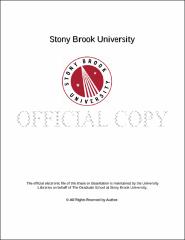| dc.identifier.uri | http://hdl.handle.net/11401/76444 | |
| dc.description.sponsorship | This work is sponsored by the Stony Brook University Graduate School in compliance with the requirements for completion of degree. | en_US |
| dc.format | Monograph | |
| dc.format.medium | Electronic Resource | en_US |
| dc.language.iso | en_US | |
| dc.publisher | The Graduate School, Stony Brook University: Stony Brook, NY. | |
| dc.type | Thesis | |
| dcterms.abstract | While the energy consumption around the world is keeping increasing, energy harvesting is more and more popular, especially in vehicle suspensions. The objective of this research is to design an electricity-harvesting shock absorber with high-power density and retrofittability to recover large amount of vibration energy traditionally dissipated in vehicle suspensions and to enhance vehicle dynamics for ride comfort and road safety at the same time. An introduction and overview of vehicle suspensions as well as regenerative shock absorbers is presented to help understand the motivation for the research. 100 to 400 Watts' energy is accessible in vehicle suspensions, which corresponds to 1-6% increase in fuel efficiency. However, current regenerative shock absorbers' energy density is low and they cannot fit in vehicles. As a result, this research is focused on increasing energy density and decreasing dimensions. In order to understand the relationship between the design parameters and dynamic performances of regenerative shock absorbers, a dynamic model for a rack-pinion type regenerative shock absorber has been derived and analyzed based on differential equations. To understand the influence of the friction and backlash on the system, nonlinear models have been created. Simulations are carried out to study the features of the design. The validation of the models is demonstrated by comparing the simulation results with experimental measurements. Guidelines are given for the design of this type of regenerative shock absorbers. Based on the guidelines, an improved design of a retrofit regenerative shock absorber is prototyped and tested. Results show that variable damping coefficients and asymmetric feature in jounce and rebound motions are achieved by controlling the electrical load of the shock absorber. Improved efficiency and reliability are achieved by utilizing a roller to guide the rack and preload on the gear transmission to reduce the backlash and friction. A peak power of 68 Watts is attained from one prototype shock absorber when the vehicle is driven at 30 mph on a fairly smooth campus road. To keep improving the regenerative shock absorbers' reliability and efficiency, an innovative design of regenerative shock absorbers is proposed, with the advantage of significantly improving energy harvesting efficiency and reducing the impact forces caused by oscillation. The key component is a unique motion mechanism, which is called " mechanical motion rectifier" , to convert the suspension's oscillatory vibration into unidirectional rotation of the generator. An implementation of motion rectifier based harvester with high compactness is introduced and prototyped. A dynamic model is created to analyze the general properties of the motion rectifier by making analogy between mechanical systems and electrical circuits. The model is capable of analyzing electrical and mechanical components at the same time. Both simulation and experiments are carried out to verify the modeling and the advantages. The prototype achieved over 60% efficiency at high frequency, much better than the conventional regenerative shock absorbers in oscillatory motion. The motion rectifier based design can also be used for other applications of electromagnetic vibration energy harvesting. A ball screw based " Mechanical Motion Rectifier" is also presented with design calculation and models because the ball screw is more reliable than rack pinion mechanism. However, there are possibly some dead zones with wrong design parameters. So, the dead zones are modeled and analyzed, and design guidelines are provided for avoiding dead zones in the future designs. The regenerative shock absorbers can not only harvest energy from vehicle vibrations, but also provide better performances with controllers. The combination of " mechanical motion rectifier" and regenerative shock absorbers improves the reliability and efficiency at the same time, which makes regenerative shock absorbers more practical and functional. | |
| dcterms.available | 2017-09-20T16:50:17Z | |
| dcterms.contributor | Zuo, Lei | en_US |
| dcterms.contributor | Kao, Imin | en_US |
| dcterms.contributor | Longtin, Jon | en_US |
| dcterms.contributor | Babajimopoulos, Aristotelis. | en_US |
| dcterms.creator | Li, Zhongjie | |
| dcterms.dateAccepted | 2017-09-20T16:50:17Z | |
| dcterms.dateSubmitted | 2017-09-20T16:50:17Z | |
| dcterms.description | Department of Mechanical Engineering. | en_US |
| dcterms.extent | 88 pg. | en_US |
| dcterms.format | Application/PDF | en_US |
| dcterms.format | Monograph | |
| dcterms.identifier | http://hdl.handle.net/11401/76444 | |
| dcterms.issued | 2012-12-01 | |
| dcterms.language | en_US | |
| dcterms.provenance | Made available in DSpace on 2017-09-20T16:50:17Z (GMT). No. of bitstreams: 1
Li_grad.sunysb_0771M_11023.pdf: 8137182 bytes, checksum: 0f6d13be556e69b995750aecc40d0f95 (MD5)
Previous issue date: 1 | en |
| dcterms.publisher | The Graduate School, Stony Brook University: Stony Brook, NY. | |
| dcterms.subject | Mechanical engineering | |
| dcterms.subject | energy harvesting, mechanical motion rectifier, regenerative shock absorber, vehicle suspension | |
| dcterms.title | Regenerative Shock Absorbers for Energy Harvesting from Vehicle Suspensions | |
| dcterms.type | Thesis | |

